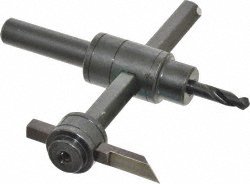Nice one Karl, the aluminium expands due to the heat and nips the blade ..same often happens with a hole saw .
Doing the chain drill exercise all way round inside the waste material at a diameter the same as your hole saw & then using a hole saw in the chain holes works well for the hole, not only does it reduce or lose the heat causing swarf & expansion problem ,there is material to cut because of what you have removed chain drilling.
The drawback is unless you have set up a four jaw chuck to do it previously you may find it difficult to centeer on th lathe.
This is how I did some 3 inch holes in some 2 & 1/2 thick alu plate . Set the carraige stop up to prevent you hitting things with the cutting tool or the carriage
Accurately mark & center the hole & dot punch it for repeatable line up's. Now carefully chain drill a concentric ring on the inside of the required final diameter. in 1/4 inch holes leaving 1/16 thick webs between holes & drill the center pop mark in 1/4 as well so you can get the same reference point when you turn the work piece over . ( If you need to turn it over that is.) .
Put it back on the lathe , line up the centre , using the face plate and some standoffs to lift thebplate off the face plate so you have clearance at breakthrough . Then turn out the webs of the chain drilled holes using the lathe using center ground point cutter at 90 degrees to the work piece to do most of the work till your well over half way through . Now reverse the work piece on the face plate & center it , cut right through ,
Now finish the final cuts with a RH cutter at 90 degrees to the work face .
Do keep things tight at in & on the tool post for on several occasions I found that the tool posts have rotated a fraction and left me with hollow cones for holes instead of parallel bores
On some smaller holes of 1 & 1/2 , 1 & 3/4 " dia in 2 & 1/2 2sqy-uare ally bar I drilled a 1/4 center hole and whacked a well ground up 1 & 1/4 morse tape drill through from both sides , then used a home made boring bar from one face only to turn out the remainder to the required size .
The cutting angle for the drill is sharper than that for mild steel , look it up. ( I've been to sleep since then .)
Because for the size of things & the need for the holes to be at the ends of an 8 inch long billet of ally I had to use the face plate and home made clamping bars & some cut down 6 " bolts , hand cutting the bolts in situ. right next to the nyloc securing nuts to give me as much clearance as possible , I also used stand off spacers behind the workpiece to put it 1/2 " away from the face plate. ( Nowt worse than unintentionally hitting your tool end on a bit of hard steel .... apparently :lmao: ) .
I thought it would take ages but once I got the speed right it didn't take long .... done at something like 87 RPM because of the out of balance of things if I recall correctly .

